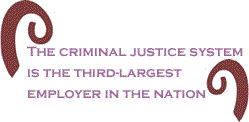| It
was couched in terms of rural economic development, but
the prison-building frenzy of the 1970s and 1980s carried
a hidden cost - social disruption of urban families and
a gross distortion of rural economies.
As
the prison-industrial complex began to take on form at the
planning tables of Corporate America and its political allies
of both major parties, it seemed that nothing could stop
its forward motion.

Until
the 1960s, New York, for example, had just seven major prisons.
In 2010, the state has 67 prisons holding 58,000 inmates,
not counting federal prisons and county or city jails.
That�s
a lot of people - prisoners and those who are paid to watch
them. What�s probably more important, it�s a lot of money
that the taxpayers are shelling out for something that�s
not being done very well - rehabilitating the inmates and
returning them to life among their fellow citizens.
Thus,
we have the designation, �correctional facility,� instead
of prison. For the amount of money spent, however, there
has been little rehabilitation or correction accomplished.
The recidivism rate in American prisons is high. Some of
the most successful programs for keeping former inmates
from a return trip to prison are those operated by private,
non-profit groups, most of which do not receive much government
money.
Before
the prison boom, New York�s major prisons - maximum security - were
relatively close to population centers, from which the bulk
of prisoners came, the one major exception being Clinton
Prison at Dannemora, built in 1845 and known for generations
as �Little Siberia.�
 By
2008, the U.S. had 2.3 million prisoners and 70 percent of
them were �non-whites,� according to a paper, �Resisting
the Prison-Industrial Complex,� from the State University
of New York at Binghamton. In all, 7.3 million were in prison, jail, on parole, or
on probation in 2008, according to the U.S. Bureau of Justice
Statistics. By
2008, the U.S. had 2.3 million prisoners and 70 percent of
them were �non-whites,� according to a paper, �Resisting
the Prison-Industrial Complex,� from the State University
of New York at Binghamton. In all, 7.3 million were in prison, jail, on parole, or
on probation in 2008, according to the U.S. Bureau of Justice
Statistics.
The
explosion of incarceration in America
is largely attributed to the so-called war on drugs, another
failed �war� that America embarked
upon and continues to this day. Mandatory sentencing was
a major factor in the imprisonment of hundreds of thousands
or millions of non-violent offenders.
At
an estimated annual cost of $18,000-$31,000 per prisoner,
you can do the math and get a hint of the massive cost of
laws gone awry. But, underneath it all, there was the opportunity
for fortunes to be made. In New
York alone, this year�s costs at the high end of incarceration
would be about $1.8 billion. And, that�s a bare-bones estimate
just for those placed in state prisons, not in the lesser
facilities or in parole or probation systems.
When
New York and the other states started their boom in prison building,
it was not - and still is not - clear whether it was seen
as a giant money-making scheme or as economic development
for the rural parts of the state, of which there are many
and they are remote. That�s how state officials sold the
�prison in your backyard� concept over the past 30 years.
They
pointed out that each prison would provide 200-300 jobs
that were well paying. That was kind of tricky, because
in the cities, officials sought support for massive prison
projects on the basis of fear of crime (including non-violent
possession of marijuana), while they sought to overcome
the fear in the rural areas of having a large population
of offenders right in their neighborhoods.
 It
was a kind of tightrope walk for officials looking to sell
incarceration as rural economic development, no matter how
it was viewed. However, there were few escapes, even from
the medium and minimum-security prisons and people settled
into having prisons between their homes and the supermarket
where they shopped every week. It
was a kind of tightrope walk for officials looking to sell
incarceration as rural economic development, no matter how
it was viewed. However, there were few escapes, even from
the medium and minimum-security prisons and people settled
into having prisons between their homes and the supermarket
where they shopped every week.
This
could be considered by some as an aside, but it is something
to be considered: it was during this same period that Corporate
America and its assorted agribusinesses were busily forcing
small farmers off the land (and this continues) and inexorably
forging the path to giant food production operations that
were (and are) more industry than family farm. Something
had to be done to replace small farms, which dispersed income
throughout the entire community, rather than the current
giant industries which take the money away from the local
economy before midnight.
A
case in point is a farm couple in Washington
County, New York, where there is an
old maximum-security prison, Great Meadows. In the prison
construction rush, a few more prisons were built nearby
about 20 years ago. The couple, who had produced milk on
their farm all of their adult lives and raised a family
there, had only one child who showed any interest in farming.
The reason was straightforward. In one year in the early
1990s, this couple, working 365 days a year, showed income
of $12,000, their school and property taxes were $8,000,
and their trucking bill (to this day, dairy farmers still
have to pay for shipping their milk after it leaves their
farm and their possession) was $19,000.
One
of their sons went to work at one of the local prisons and,
in his first year, he was being paid about $30,000 in base
annual wages, plus benefits. Looking at how his parents
had worked and how the manipulated milk �market� compensated
them, it was not surprising that he would not be staying
on the farm.

According
to a Nov. 8 report in The Boston Globe, America spent a total of $33 billion on the criminal
justice system in 1980. In 2010, that amount rose to $216
billion, making the criminal justice system the third-largest
employer in the nation. Lots of that money went toward an
attempt to rebalance the damage done to rural economies
by U.S.
agricultural policies.
At
the beginning of this new century, there is no solution
in sight for the twin problems of crime-and-punishment failure
and the failure of agricultural policies that have driven
small farmers off the land in record numbers, because of
the manipulation of �agricultural markets,� which are seen
increasingly as being under the control of anonymous (and
some not so anonymous) power brokers. Likewise, the courts
and the legislatures - as well as the Congress - are seen
as dealing with problems by creating fear, then addressing
those fears by literally throwing money at them.
Politicians
have been very generous in spreading that wealth over the
state as evenly as possible, satisfying to some degree the
cries for rural economic development, but prisons have proven
themselves to be a dead end in that regard, since there
is little rehabilitation. The money that might have gone
for education and programs is used just to lock the gates
and pay the people who keep watch. And, prisons are notable
for not being healthy places to live or work.
Racist
drug laws and other racist aspects of the justice system
have put urban citizens in prisons far from their own homes,
so that families find it difficult or impossible to maintain
relationships.  That
makes it tough to reintegrate into one�s community and does
nothing to help ex-inmates stay out of the system. That
makes it tough to reintegrate into one�s community and does
nothing to help ex-inmates stay out of the system.
For
a few decades, the prison-industrial complex (rife with
privatization of prisons, in which the bottom line is the
first and sometimes only objective) gave cover to the failure
of government and corporate policy regarding the rural areas
of the entire country. But the result of those problems
and the half-baked and ill-conceived �solutions� to the
problems are now becoming evident.
The
U.S. cannot lock up a significant proportion of
its people and expect a healthy outcome, either for those
imprisoned or the population as a whole. It makes the society
sick and there doesn�t seem to be a cure in sight. The vast
rural areas of America are suffering economically
and no amount of prison building will make up for the elimination
of small farm agriculture.
In
both our prison system and agriculture, there needs to be
an admission that modern policies have failed and that the
crisis is here. What America needs now is a fully funded project that
restores millions of small farmers to the countryside and
promotes revolutionary changes in the justice system, such
as the rescinding of laws like the drug laws, which have
filled our prisons mostly with people of color.
 Locating
prisons in the rural areas was not economic development.
It was a sign that leadership in both major parties failed
in two of the most important areas of our national life.
The reassessment of agricultural policies and the justice-and-prison
system needs to begin immediately. As with our endangered
physical environment, we don�t have much time. Locating
prisons in the rural areas was not economic development.
It was a sign that leadership in both major parties failed
in two of the most important areas of our national life.
The reassessment of agricultural policies and the justice-and-prison
system needs to begin immediately. As with our endangered
physical environment, we don�t have much time.
BlackCommentator.com
Columnist, John Funiciello, is a labor organizer and former
union organizer. His union work started when he became a
local president of The Newspaper Guild in the early 1970s.
He was a reporter for 14 years for newspapers in New York State. In
addition to labor work, he is organizing family farmers
as they struggle to stay on the land under enormous pressure
from factory food producers and land developers. Click here
to contact Mr. Funiciello. |

